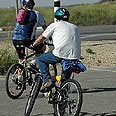
Touring the country
Photo: Ze'ev Trachtman
Despite the expected rainy weather, many people took advantage of the Sukkot
holiday on Tuesday in order to spend time on Israel’s
travel routes.
Guesthouse owners in the northern Negev expressed their satisfaction that the ceasefire brought Israeli tourists back to the area.
Holiday Fun
Yoav Friedman
Ynet offers a quick guide to some of the activites guaranteed to keep you busy during Sukkot holiday
Data gathered by the Jewish National Fund revealed that this holiday 80,000 people visited the country’s parks and half of them made their way up north.
Occupancy in the northern Negev’s lodging locations was on average at about 80% but there were places left with many vacant spots.
“The cabins and lodging sites filled up at the last minute despite our fears, and now most of them are full,” Livnat Ginsburg, the regional tourism director for the northern Negev, told Ynet.
“To our satisfaction, the fears we had proved false. It takes time for the public to place their trust in the new-found calm.”
Ginsburg added that the “Feeling at Home” festival in Sderot will take place until the weekend and "we hope that the event will contribute to additional movement on the tourists’ part. Thousands of people are expected at the festival. Our goal is that the celebration will bring people to the entire northern Negev.”
Raviv Shapira, who is in charge of the southern district of the Israel Nature and Parks Protection Authority, said that many Israelis came down south. “There is a nice influx of visitors in the south,” he said.
“The weather was nice and in relation to holidays that fall on a Sunday, there were many visitors. About 2,000 people arrived at the Nabatean market in Mamshit, 2,000 people arrived at Ein Gedi and 1,000 visitors came to the Eshkol National Park,” said Shapira.
'Israelis disposed of garbage'
Shapira noted that there are many tourists on jeep tours in the area of the Dead Sea, the descent into the Arava, the Nahal Zin gorge Sde Boker and the Ramon Crater.“Autumn crocuses started blooming in Yerucham and the event is a huge attraction pulling many tourists,” he said.
According to Shapira, the amount of tourists is expected to keep on growing during the Sukkot holiday. “We only ask that the visitors make sure to exhibit caution, take water with them and clean up after themselves,” he said.
The Jewish Naitonal Fund noted that the tourists made sure to maintain the sites, disposed of their garbage and kept it in one general location.
Ofra Gazit, Spokeswoman for the Tamar Regional Council said that towards the Tamar Festival which will take place for its ninth year, 100,000 visitors are expected to arrive during the mid-holidays.
“These are also people who will be traveling in the area of the streams and mountains in the region,” she explained. The festival will take place on the Sukkot mid-holidays between October 15-19.
About 5,000 Israeli tourists arrived in the northern Galilee to get a glimpse at the pelicans and cranes nesting there. About 2,500 visitors arrived at the Biriya Forest near Safed and others arrived in the Carmel forests.
Hundreds of people made their way to the Tel Hai Museum in which a kite race for Israel’s 60th anniversary celebrations will take place during the holiday.
The Golan Heights is full of jovial holiday activities like the sculpture festival in Bazelet which will take place at the Orvim Park near Ha'amir junction. Kibbutz Ein Zivan is also holding an “Apple Happening” which will mostly include apple-picking.
Hagai Einav contributed to this report















